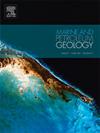约旦塞诺曼尼亚-土鲁尼亚边界旋回地层
IF 3.6
2区 地球科学
Q1 GEOSCIENCES, MULTIDISCIPLINARY
引用次数: 0
摘要
Cenomanian-Turonian间隔(晚白垩纪,~ 9400万年前)的时间尺度和相关的环境变化仍然存在争议。特别是,标志海洋性缺氧事件2 (OAE2)的正碳同位素偏移(CIE)的持续时间存在争议。本文提出了约旦北部扎尔卡地区塞诺曼尼亚-土尔onian界线的天文时间标度。磁化率资料和稳定碳同位素(δ13Ccarbonate)资料的旋回地层分析表明,平均最佳沉积速率为1.82 cm / 1000年。高分辨率天文时间尺度表明,正δ13C峰值a-d持续约0.88 Myr,与偏心率周期E231和E233相关。δ13C峰值d的顶部出现了约240 kyr的间隙。数据表明,C/T转变与La10c天文解的偏心最小节点(2.4 myr g4-g3)相关,数据中明显的幅度和频率调制支持了这一点。分析数据中不同轨道参数的表达表明,在Cenomanian-Turonian过渡期间,地球太阳轨道的变化直接影响了碳循环和环境条件。本文章由计算机程序翻译,如有差异,请以英文原文为准。
Cyclostratigraphy of the Cenomanian-Turonian boundary in Jordan
The timescale of the Cenomanian-Turonian interval (Late Cretaceous, ∼94 million years ago) and associated environmental changes remain debated. In particular, the duration of the positive carbon isotope excursion (CIE), marking Oceanic Anoxic Event 2 (OAE2), is subject to controversies. This study presents an astronomical timescale for the Cenomanian-Turonian boundary in the Zarqa section of northern Jordan. Cyclostratigraphic analysis of magnetic susceptibility data and stable carbon isotope data (δ13Ccarbonate) reveals an averaged optimal sediment accumulation rate of 1.82 cm per thousand years. The high-resolution astronomical timescale suggests that the positive CIE, marked by positive δ13C spikes a-d, lasted about 0.88 Myr and can be correlated to eccentricity cycles E231 and E233. A hiatus of about 240 kyr occurs at the top of the δ13C spike d. The data indicate that the C/T transition correlates to an eccentricity minima node (2.4 myr g4-g3) of the La10c astronomical solution, as supported by amplitude and frequency modulation that are evident in the data. The expression of distinct orbital parameters in the analytical data suggest that during the Cenomanian-Turonian transition changes in Earth solar orbit directly impacted carbon cycling and environmental conditions.
求助全文
通过发布文献求助,成功后即可免费获取论文全文。
去求助
来源期刊

Marine and Petroleum Geology
地学-地球科学综合
CiteScore
8.80
自引率
14.30%
发文量
475
审稿时长
63 days
期刊介绍:
Marine and Petroleum Geology is the pre-eminent international forum for the exchange of multidisciplinary concepts, interpretations and techniques for all concerned with marine and petroleum geology in industry, government and academia. Rapid bimonthly publication allows early communications of papers or short communications to the geoscience community.
Marine and Petroleum Geology is essential reading for geologists, geophysicists and explorationists in industry, government and academia working in the following areas: marine geology; basin analysis and evaluation; organic geochemistry; reserve/resource estimation; seismic stratigraphy; thermal models of basic evolution; sedimentary geology; continental margins; geophysical interpretation; structural geology/tectonics; formation evaluation techniques; well logging.
 求助内容:
求助内容: 应助结果提醒方式:
应助结果提醒方式:


